After spending a night in Salzburg, we decided to take a day trip to Hallstatt, the picturesque village in Austria that has long been on my travel bucket list.
Hallstatt was the main reason I visited Austria this time. In fact, I stayed in Salzburg just to be closer to Hallstatt (though I eventually fell in love with Salzburg and the Austrian countryside too). The journey to Hallstatt began at dawn. By 5:30 AM, Kyle and I were ready to leave the Meininger Salzburg Hotel and head to the bus stop. Why so early? Well, after doing some research and reading other travelers’ experiences, I learned that Hallstatt, which has become increasingly popular, tends to be packed with tourists by midday. So, to enjoy Hallstatt in peace, we made sure to be at the bus stop, just five minutes from the hotel, before 6 AM.
JOURNEY TO HALLSTATT: HOW TO GET THERE

From Salzburg, I took bus number 150 heading to Bad Ischl (ticket: €13), then switched to a train at Bad Ischl station heading to Hallstatt station (ticket: €6). Afterward, the journey to Hallstatt continued with a 5-minute boat ride (ticket: €2.50) to the village. The total travel time from Salzburg to Hallstatt is about 2 hours and 15 minutes. However, there are two other ways to get to Hallstatt from Salzburg. The first option is taking a train from Salzburg Hauptbahnhof to Attnang-Puchheim station, then switching to a train bound for Hallstatt, followed by a boat ride to the village. The third option is taking bus number 150 from Salzburg Hauptbahnhof to Bad Ischl, then switching to bus number 542 or 543 to Gosaumühle/Hallstatt before boarding a boat to the village.
If you’re traveling to Hallstatt from Vienna, take a train from Vienna Hauptbahnhof to Attnang-Puchheim, then switch to a train to Hallstatt station, and finally take a boat to the village. This journey takes about 3 hours and 22 minutes.
JOURNEY TO HALLSTATT: OVERVIEW
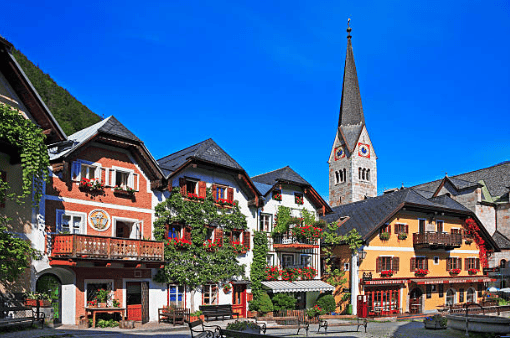
A few years ago, Hallstatt was often called Austria’s hidden gem. Now, that title no longer fits. Hallstatt has become one of Austria’s top tourist destinations thanks to its stunning natural scenery, featuring lakes and mountains, along with its classic Austrian houses that are incredibly Instagram-worthy. This lakeside village, which looks straight out of a fairytale, attracts 800,000 tourists every year, most of whom are from Asian countries like China and South Korea. Hallstatt’s popularity in Asia even led a real estate developer in China to build a replica of the village in Baluo County, Luoyang.
Located 2.5 hours from Salzburg, Hallstatt offers plenty of sights for tourists who love nature, history, and architecture. The village is easily accessible by train or bus from Salzburg or Vienna. Hallstatt’s fairytale-like architecture and breathtaking surroundings make it a perfect destination for either a day trip or a longer stay.
JOURNEY TO HALLSTATT: HISTORY OF HALLSTATT

Nestled between the end of Lake Hallstatt and the towering Dachstein Mountains is the oldest and most captivating village in Austria. Hallstatt, which now has a reputation as a trendy tourist destination, has a history dating back more than 7,000 years. Between 800 and 450 BC, Hallstatt was a prosperous village known for its salt production. At that time, salt was a valuable commodity used for preserving food and other items. Thanks to its salt mining activities, Hallstatt’s economy flourished, turning the small village into a thriving trade hub. In 1595, Hallstatt began transporting salt to other towns like Bad Ischl and Ebensee using a brine pipeline.
Although salt production has ceased, Hallstatt’s fame has skyrocketed due to tourism. The former salt mines, along with the village and its surrounding nature, have been recognized as a UNESCO World Heritage Site since 1997. Today, tourism is the main economic driver for Hallstatt’s residents, who have turned their homes into guesthouses, hotels, restaurants, cafés, and souvenir shops. Hundreds of tourists from around the world visit Hallstatt daily, making the village, with a population of less than 1,000, constantly bustling.
JOURNEY TO HALLSTATT: GETTING AROUND

Hallstatt is a small village with only about 1,000 residents, so walking is the best way to explore it. Be prepared for some physical exertion, as you’ll often need to climb stairs and inclines, especially if you’re hiking to the top of the hills. To reach attractions like the salt mine and skywalk, you can take the funicular. For a scenic experience of Lake Hallstatt, you can take a 50-minute boat tour around the lake, with tickets costing €10 per person. If you’re only in Hallstatt for a day trip, it’s best to leave the village before 6 PM, as the last train departs at 6:20 PM.
Austria is part of the European Union, and the currency used is the Euro. The official language is German, but English is widely spoken to communicate with tourists. Both cash and credit cards are accepted in Hallstatt.
JOURNEY TO HALLSTATT: THINGS TO SEE & DO
Thanks to our early start, we arrived in Hallstatt just before 9 AM. It was a perfect time, as the village was still quiet, with only about 20 people around when we got off the boat. By noon, though, the village was packed with tourists, mostly from Asia. Here are some of the top sights and activities in Hallstatt:
1. Market Square: The heart of Hallstatt, surrounded by charming classic Austrian houses adorned with wooden details and flowers. The square is small but highly Instagrammable, with cafés, restaurants, hotels, and a statue of the Holy Trinity in the center.
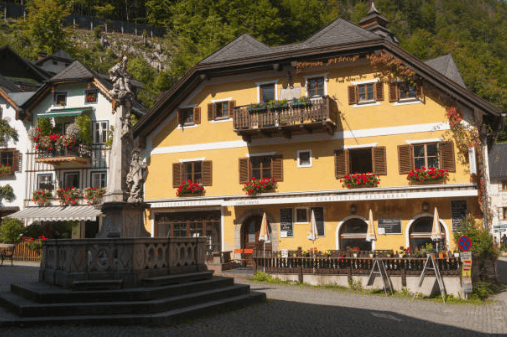
2. Lake Hallstatt: Taking a boat ride on the lake is one of the best ways to appreciate its beauty, with two main routes that pass by scenic spots, including romantic castles and secluded beaches. You can also swim, sunbathe, or go diving in the lake during summer.
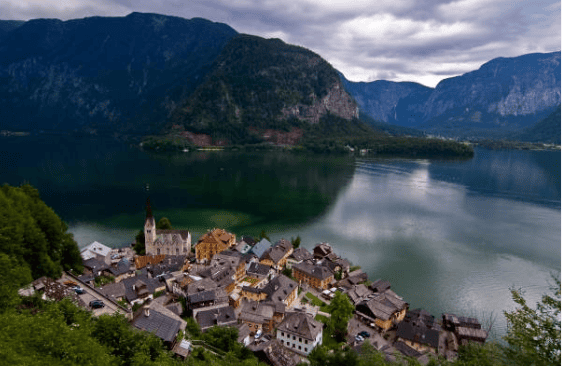
3. Parish Church of the Assumption: A Gothic-style Catholic church perched on a hill overlooking the lake. Its double-winged altar is a highlight of the village’s historical architecture.

4. Charnel House/Ossuary: This chapel contains 1,200 human skulls, some of which are painted and marked with the names of the deceased. A unique and somber tradition of Hallstatt, due to the limited burial space.

5. Salt Mine: The world’s oldest salt mine, dating back 7,000 years, offers guided tours where visitors can learn about the village’s rich history and even slide down into the mine on wooden slides.
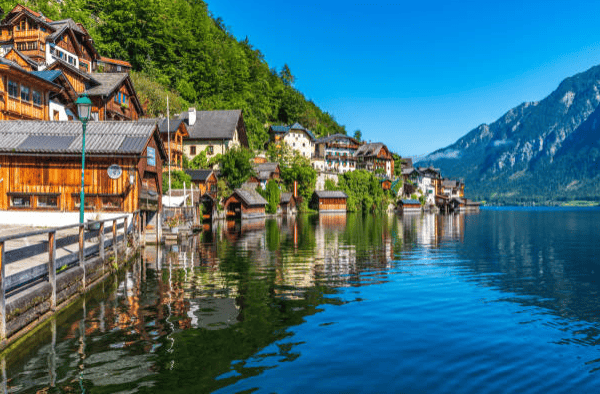
6. Skywalk: A must-see viewpoint, 350 meters above sea level, offering breathtaking views of Hallstatt, the lake, and the surrounding mountains.
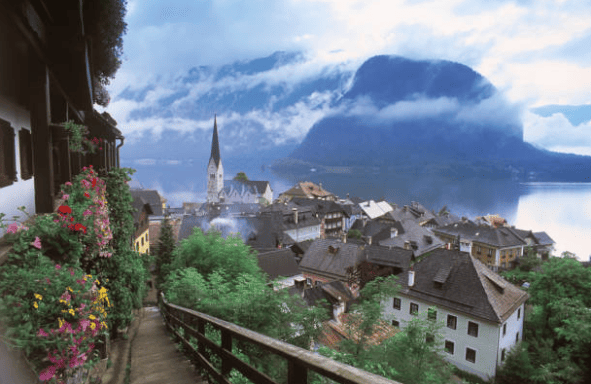
7. Dachstein Suspension Bridge: For adventure lovers, this suspension bridge at an altitude of 2,700 meters offers panoramic views of the Dachstein Glacier.
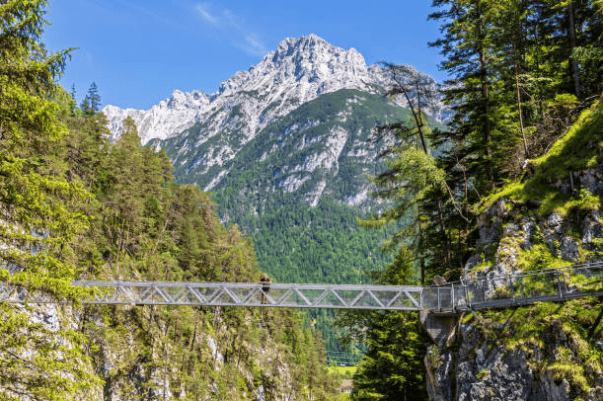
8. Dachstein Giant Ice Cave: A natural wonder with giant stalactites and stalagmites, lit up by laser shows, that can be explored on guided tours between May and October.

I visited Hallstatt in October, one of the best times to avoid the heavy crowds. If you’re planning a trip, consider visiting during the quieter months of March, April, May, October, or November to fully enjoy the village’s charm.
